Time Of Flight Sensor Market Research, 2031
The Global Time Of Flight Sensor Market was valued at $2.7 billion in 2021, and is projected to reach $13 billion by 2031, growing at a CAGR of 16.9% from 2022 to 2031.
The time of flight principle (ToF) is a method for measuring the distance between a sensor and an object, based on the time difference between the emission of a signal and its return to the sensor, after being reflected by an object. Various types of signals (also called carriers) can be used with the time of flight principle, the most common being sound and light. These sensors are used for a range of applications, including robot navigation, vehicle monitoring, people counting, and object detection. Surge in adoption of machine vision systems across different industries plays a vital role in driving the growth the market. In general, machine vision applications require highly stable and reliable sensory systems. Tof 3d camera and tof sensor provide a reliable set of depth data, increasing the robustness and flexibility of many surveillance, inspection, and logistics systems.
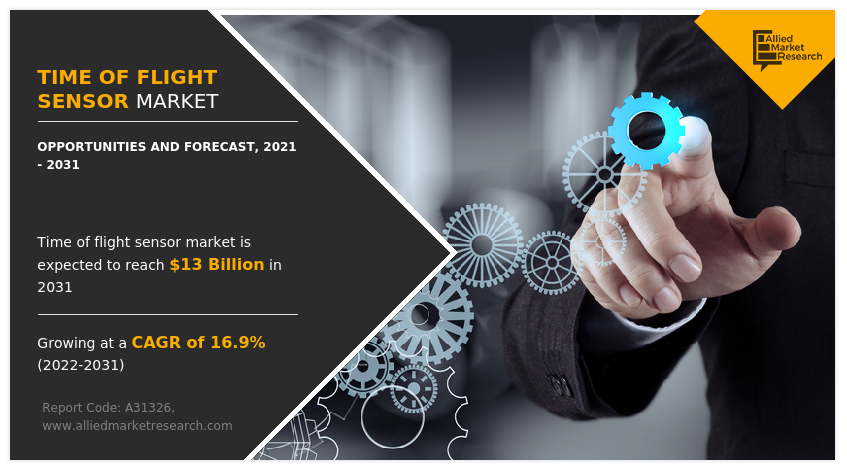
Segment Overview
The time of flight sensor industry is segmented into Product Type, Application and End User.
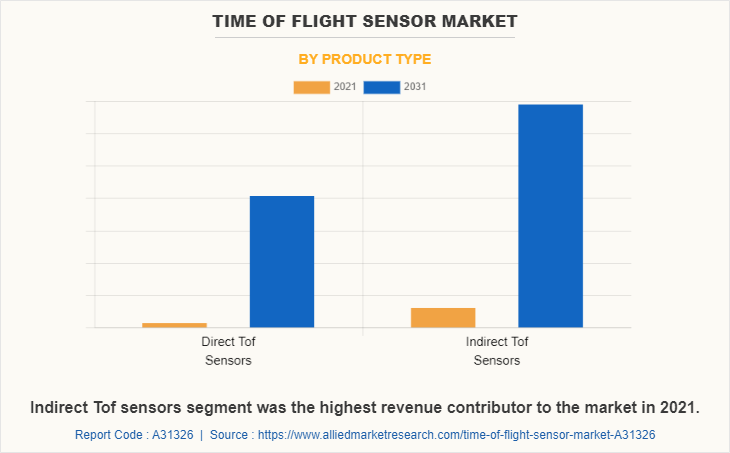
By product type, the market is divided into indirect ToF imagers and direct ToF imagers. The indirect ToF imagers segment was the highest revenue contributor to the market in 2021.
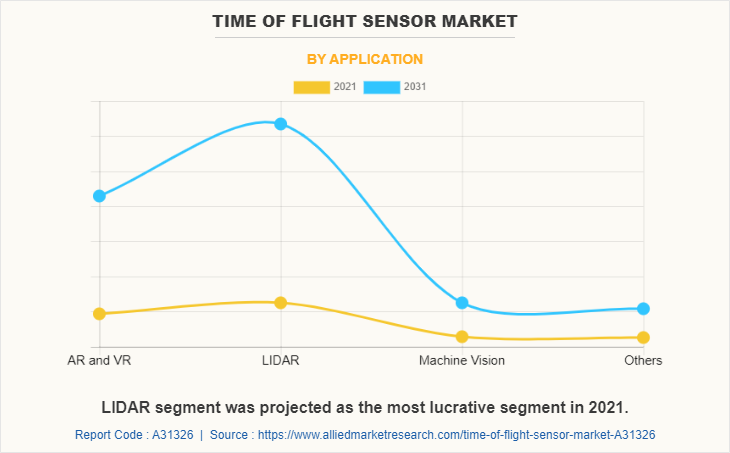
By application, the market is analyzed across AR & VR, LIDAR, machine vision, and others. The LIDAR segment was the highest revenue contributor to the market in 2021.
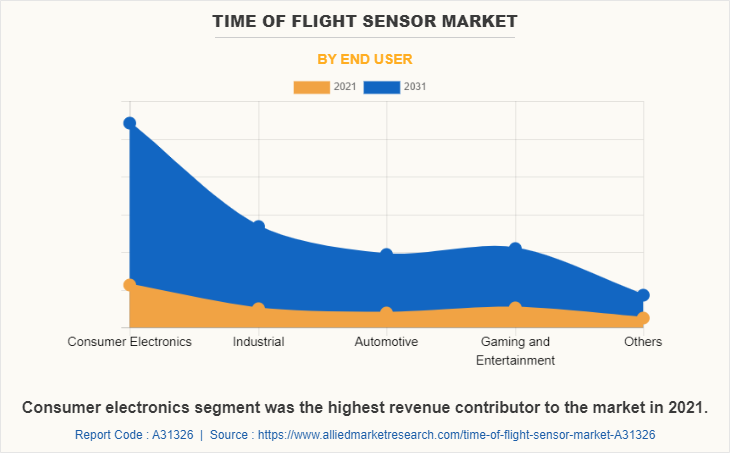
The end user segment is divided into automotive, consumer electronics, gaming & entertainment, industrial, and others. The consumer electronics segment was the highest revenue contributor to the market in 2021.
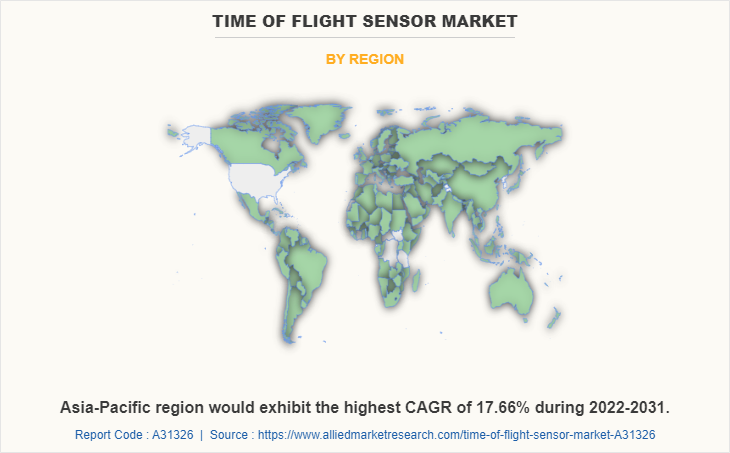
Region-wise, the time of flight sensor market trends are analyzed across North America (the U.S., Canada, and Mexico), Europe (UK, Germany, France, Italy, Spain, Russia, Netherlands, Belgium, Poland, and rest of Europe), Asia-Pacific (China, Japan, India, South Korea, Australia, Malaysia, Thailand, Philippines, Indonesia, and rest of Asia-Pacific), and LAMEA (Latin America, the Middle East, and Africa).
Applications of time of flight sensors include, automated materials handling systems, which operate at moderate distances and require more accurate measurements of about one to five millimeters. The preference towards single-pixel ToF imagers is highly being adopted for full-field imagers, which is cascaded through modulating elements and is incorporated into the correlation ToF architecture.
The time of flight sensor industry is expected to witness notable growth during the forecast period, owing to the growing R&D activities in consumer electronics and rising infrastructural modernization in semiconductor and microelectronics sector. Moreover, with the increasing demand for 3D cameras, the growth of the time of flight sensor rises significantly.
Significant factors that impact the growth of the time of flight sensor market size include rise in demand for 3D imaging. Moreover, rapid increase in demand of smart consumer electronics devices also is expected to drive the market opportunity. However, lack of awareness about this technology is projected to hamper the time of flight sensor market growth. On the contrary, emerging integrations of consumer electronics in the automotive industry and rising demands from autonomous vehicles is offering potential growth opportunity for the time of flight sensor market share during the forecast period.
The key players profiled in the report include, Texas Instruments Incorporated, STMicroelectronics NV, Infineon Technologies AG, Panasonic Corporation, Teledyne Technologies Incorporated, Sharp Corporation, Sony Corporation, Boardcom Inc., OMRON Corporation, and Renesas Electronics.
Key Benefits For Stakeholders
- This report provides a quantitative analysis of the market segments, current trends, estimations, and dynamics of the time of flight sensor market analysis from 2021 to 2031 to identify the prevailing time of flight sensor market opportunity.
- The market research is offered along with information related to key drivers, restraints, and opportunities.
- Porter's five forces analysis highlights the potency of buyers and suppliers to enable stakeholders make profit-oriented business decisions and strengthen their supplier-buyer network.
- In-depth analysis of the time of flight sensor market outlook assists to determine the prevailing market opportunities.
- Major countries in each region are mapped according to their revenue contribution to the global market.
- Market player positioning facilitates benchmarking and provides a clear understanding of the present position of the market players.
- The report includes the analysis of the regional as well as global time of flight sensor market trends, key players, market segments, application areas, time of flight sensor market forecast and market growth strategies.
Time of Flight Sensor Market Report Highlights
| Aspects | Details |
| Market Size By 2031 | USD 13 billion |
| Growth Rate | CAGR of 16.9% |
| Forecast period | 2021 - 2031 |
| Report Pages | 296 |
| By Product Type |
|
| By Application |
|
| By End User |
|
| By Region |
|
| Key Market Players | Teledyne Technologies Incorporated, STMicroelectronics N.V., Texas Instruments Incorporated, Infineon Technologies, Panasonic Corporation, Sharp Corporation, Renesas Electronics, Broadcom Inc., Sony Corporation, Omron Corporation |
Analyst Review
The time of flight sensor market holds high growth potential. The current business scenario experiences increase in usage of time of flight sensor in automotive and consumer electronics industries due to advancement of electronic products in the market.
Time-of-flight is one of the several methods of capturing 3D images, alongside other cameras, including stereoscopic cameras (ones that have two separate lenses to imitate human vision and recreate depth perception) or structured light imaging (where a structured image, such as a grid, is projected onto an object and the shape and distance of that object is calculated based on the distortion to the grid). Growing R&D funding for the development of 3D imaging techniques play a vital role in driving the growth of the market.
The key players profiled in the report include, Texas Instruments Incorporated, STMicroelectronics NV, Infineon Technologies AG, Panasonic Corporation, Teledyne Technologies Incorporated, Sharp Corporation, Sony Corporation, Boardcom Inc., OMRON Corporation, and Renesas Electronics.
The Time of Flight Sensor Market is anticipated to grow at a CAGR of 16.92% during the forecast period.
The Time of Flight Sensor Market is projected to reach $12,960.7 million by 2031.
The key players to hold the major share of Time of Flight Sensor Market are Texas Instruments Incorporated, STMicroelectronics NV, Infineon Technologies AG, Panasonic Corporation and others.
The time of flight sensor market is segmented on the basis of product type, application, end user, and region.
By application, the Time of Flight Sensor Market is analyzed across AR & VR, LIDAR, machine vision, and others.
Loading Table Of Content...



